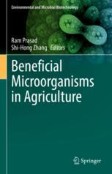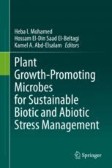Search
Search Results
-
Acid coating to increase availability of zinc in phosphate fertilizers
BackgroundPrecipitation of Zn phosphates may limit Zn availability in cogranulated P fertilizers. We assessed whether the Zn availability of Zn could...

-
Synthesis of Elemental- and Nano-sulfur-enriched Bio-organic Phosphate Composites, and Their Impact on Nutrients Bioavailability and Maize Growth
Higher pH of calcareous soils and mineral fertilizers lowers the bioavailability of plant nutrients. Hence, it requires amending the nature of...

-
Phosphate Solubilizing Microorganisms: Potential Bioinoculants for Sustainable Agriculture
Despite its availability in both organic and inorganic forms, phosphorus (P) is typically inaccessible for plant uptake due to its complexation with...
-
Single-cell Raman-activated sorting and cultivation (scRACS-Culture) for assessing and mining in situ phosphate-solubilizing microbes from nature
Due to the challenges in detecting in situ activity and cultivating the not-yet-cultured, functional assessment and mining of living microbes from...

-
Phosphate solubilizing bacteria, Pseudomonas aeruginosa, improve the growth and yield of groundnut (Arachis hypogaea L.)
For agricultural safety and sustainability, instead of synthetic fertilizers the eco-friendly and inexpensive biological applications include members...

-
Reductive dissolution of pyrite by methanogenic archaea
The formation and fate of pyrite (FeS 2 ) modulates global iron, sulfur, carbon, and oxygen biogeochemical cycles and has done so since early in...

-
Phosphate solubilizing epilithic and endolithic bacteria isolated from clastic sedimentary rocks, Murree lower Himalaya, Pakistan
Rock microbes are capable to solubilize phosphate present in the rocks.. In this study, we focused on the isolation of phosphate solubilizing...

-
Impact of Contrasting Rates of Phosphate Fertiliser Addition in Two Vertisols: Effects of Fresh Application and Residual Fertiliser on Sorption and Plant Uptake
Crop** systems in many sub-tropical and tropical regions rely on phosphorus (P) fertilisers to maintain crop yields. However, crop responses are...

-
Mycorrhizal symbiosis-induced abiotic stress mitigation through phosphate transporters in Solanum lycopersicum L
Arbuscular mycorrhizal (AM) symbiosis and abiotic stress mitigation have intrigued researchers for more than a century, but how different phosphate...

-

-
How understanding soil chemistry can lead to better phosphate fertilizer practice: a 68 year journey (so far)
This paper describes a journey which started with the question: why do farmers reapply phosphate? This led to understanding how phosphate and other...

-
Chemical Properties of Some Alkaline Sandy Soils and Their Effects on Phosphorus Dynamics with Bone Char Application as a Renewable Resource of Phosphate Fertilizer
Several chemical properties of alkaline soils play an important role in dissolving phosphate minerals, which greatly affect the phosphorous...
-
Arbuscular mycorrhizae increase biomass and nutrient uptake of tomato fertilized with struvite compared to monoammonium phosphate
PurposeStruvite is a wastewater-derived P mineral that offers a means to redirect wastestream P flows to agroecosystems. The low water solubility of...

-
Experimental evidence for enzymatic cell wall dissolution in a microbial protoplast feeder (Orciraptor agilis, Viridiraptoridae)
BackgroundSeveral protists have evolved the ability to perforate the cell walls of algae and fungi to specifically feed on their cell contents. These...

-
Phosphate Glass-Based Controlled-Release Fertilizers Improve Wheat Growth, Yield and Grain Nutritional Quality Under Field Conditions
The controlled release fertilizers, such as phosphate glass fertilizers (GF), constitute the future of the chemical fertilizers industry. This study...

-
Role of Phosphate-Solubilising Microorganisms in Agricultural Development
Phosphorus is enlisted as a growth-limiting element, but this falls under the category of limited non-renewable resources due to continuous mining of...
-
Weathered granites and soils harbour microbes with lanthanide-dependent methylotrophic enzymes
BackgroundPrior to soil formation, phosphate liberated by rock weathering is often sequestered into highly insoluble lanthanide phosphate minerals....

-
Arbuscular Mycorrhizal Fungi as Solubilizers of Rock Phosphate and Compost Application Improve Date Palm (Phoenix dactylifera L.)’s Resilience to Drought
Agricultural drought presents plants with the challenge of withstanding environmental constraints, amid climate change and global warming escalating...

-
Silicon-Rich Agro-wastes in Conjunction with Phosphate-Solubilizing Microbe Can Synergistically Solubilize the Recalcitrant Soil Phosphorus in a semi-arid Tropical Inceptisol
Researchers are pursuing strategies to utilize the soil’s recalcitrant phosphorus (P) pool as rock phosphate reserves are depleting rapidly....

-
Environmentally relevant concentrations of tris (2-chloroethyl) phosphate (TCEP) induce hepatotoxicity in zebrafish (Danio rerio): a whole life-cycle assessment
Tris (2-chloroethyl) phosphate (TCEP), a typical organophosphate flame retardant, is of increasingly great concern considering their ubiquitous...

